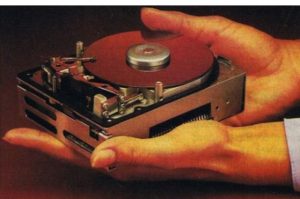History (1985): HP 97501 HDD
With first commercially significant usage of carbon over-coated sputtered recording layer media
This is a Press Release edited by StorageNewsletter.com on January 23, 2019 at 2:17 pmThis article was published by WikiFoundry.
1985: HP 97501
First commercially significant usage of carbon over-coated
sputtered recording layer media in a disk drive

Why it’s important
The superior consistency, higher quality and long life of sputtered metals recording layers with protective carbon overcoating caused rapid replacement of the prior plated metal and oxide recording layer media. Today all HDD media use this technology.
Discussion
The incorporation of a sputtered thin film magnetic disk in the HP 97501A 3.5-inch 10MB HDD culminated several years of effort at HP Laboratories and HP’s Disk Memory and Greeley Divisions.
The thin-film disk, in which a magnetic metallic layer acts as the data storage medium, represented a major technology advance in rigid magnetic recording disks. The use of vacuum sputtering deposition instead of plating for the production of the thin film led to much tighter process control, higher yields, better manufacturability and lower costs.
ln 1977, Dick Hackborn, then general manager of the newly formed Disc Memory Division, initiated the program. He believed that as magnetic recording technology evolved, the thin film magnetic disk would play a crucial role in future disk drives. Production shipment of the HP 97501 began in March 1985. The drive development teams were managed by Duncan Terry, Winston Mitchell, and Doug Mello.
The drive was originally planned for shipment in early 1984 with a disk overcoat of cobalt oxide for wear resistance and corrosion protection; however it was discovered at the very last minute that cobalt oxide formed a battery with the cobalt-platinum recording layer in the presence of even low humidity, dissolving away the recording layer. Development of a carbon overcoating delayed the shipment of production drives until March 1985,
Start-up commercial media vendors began shipping samples of similar media in the middle of 1984 to HDD manufacturers such as Maxtor and Vertex, TriMedia, founded 1983, was likely first in June 1984 with a cobalt-chrome-tantalum recording layer followed closely by Komag, also founded 1983, shipping in July 1984 using a cobalt-nickel-platinum recording layer. Much of this early production of the commercial media suppliers was to replace the unreliable Alar plated media in existing HDD designs so exact drive shipment dates are not known, However, no HDD manufacturer is known to have shipped production drives incorporating such media prior to HP. By the middle 1990s a cobalt-chrome-tantalum recording layer was the preferred recording layer for longitudinal recording.
The HP97501A recorded at 1,100 tracks per inch and 12,000 bits per inch for an areal density of 1.3Mb per square inch. Its unformatted capacity was 14.09MB with a 10MB formatted capacity at 7,168 bytes/track and 256 bytes/sector. It transferred data at a rate of 4Mb/s. Average seek time was 75ms, maximum seek time 150ms and average latency was 10ms. The drive was available in SCSI and IEEE 488 interfaces.












 Subscribe to our free daily newsletter
Subscribe to our free daily newsletter
